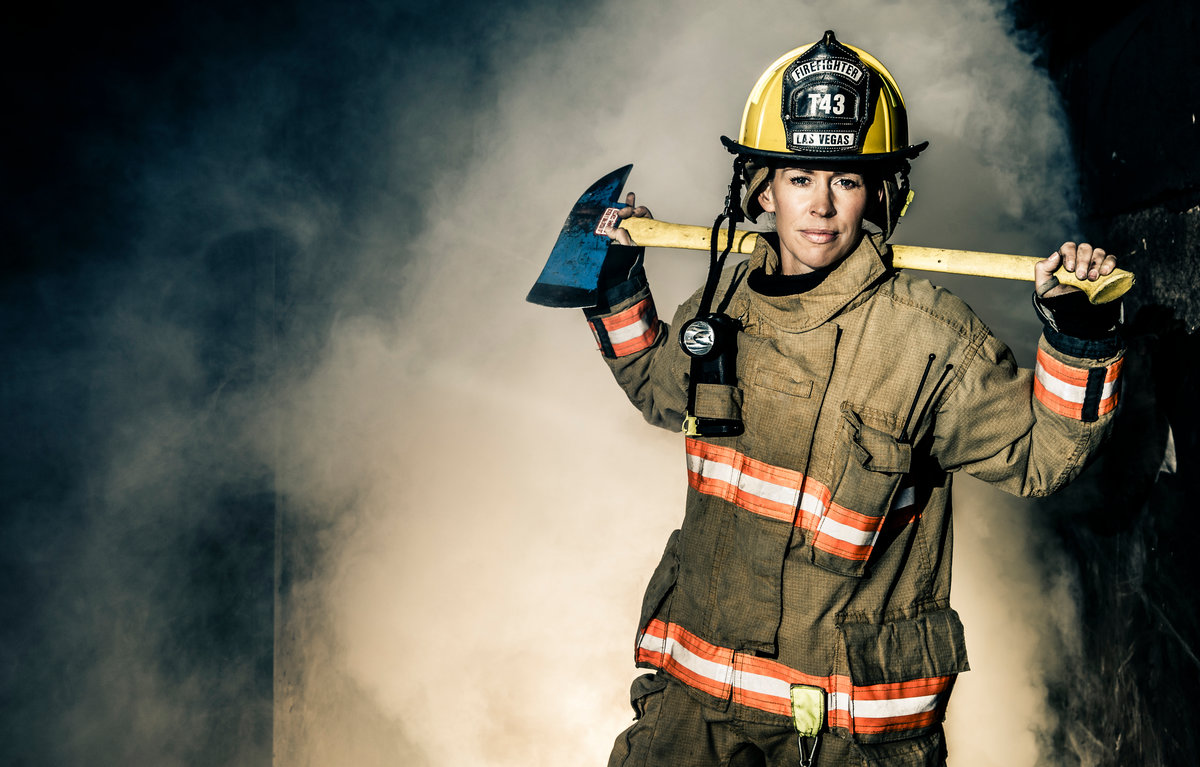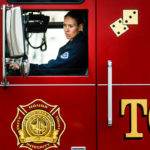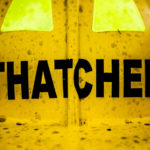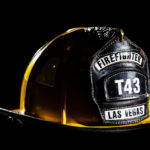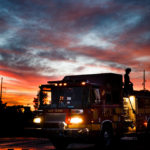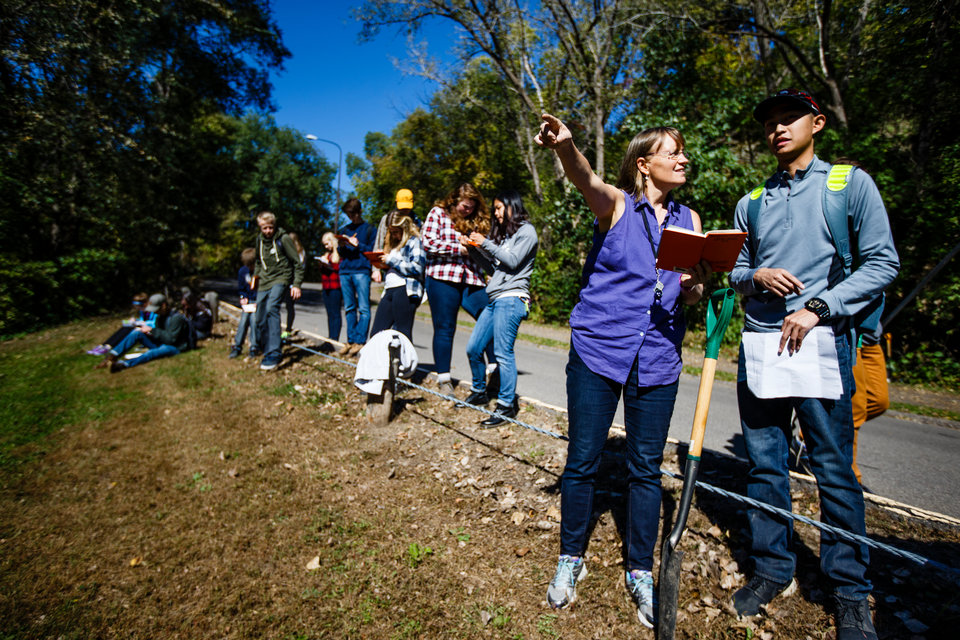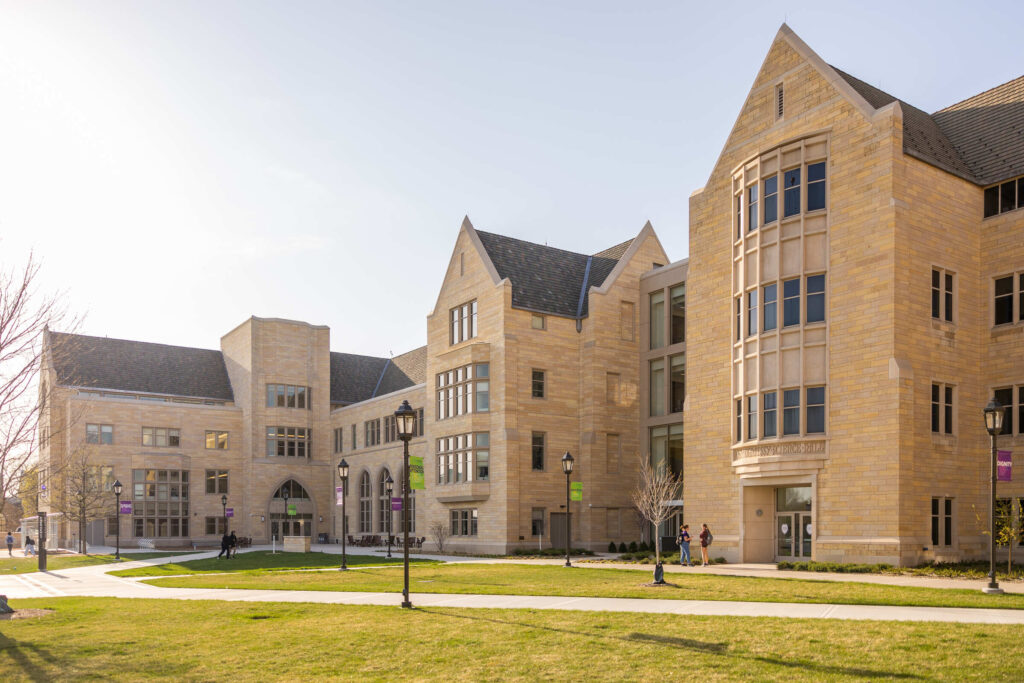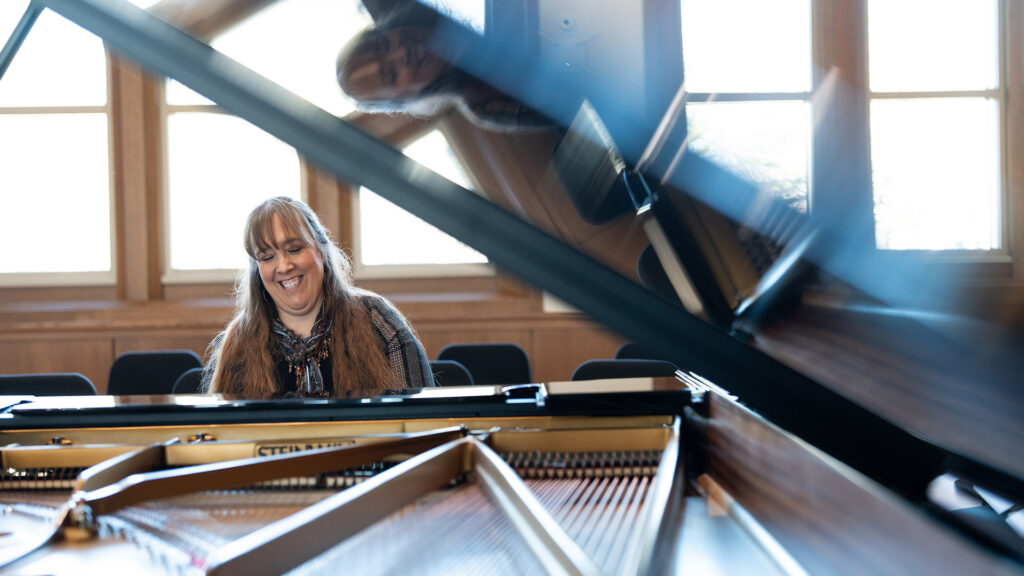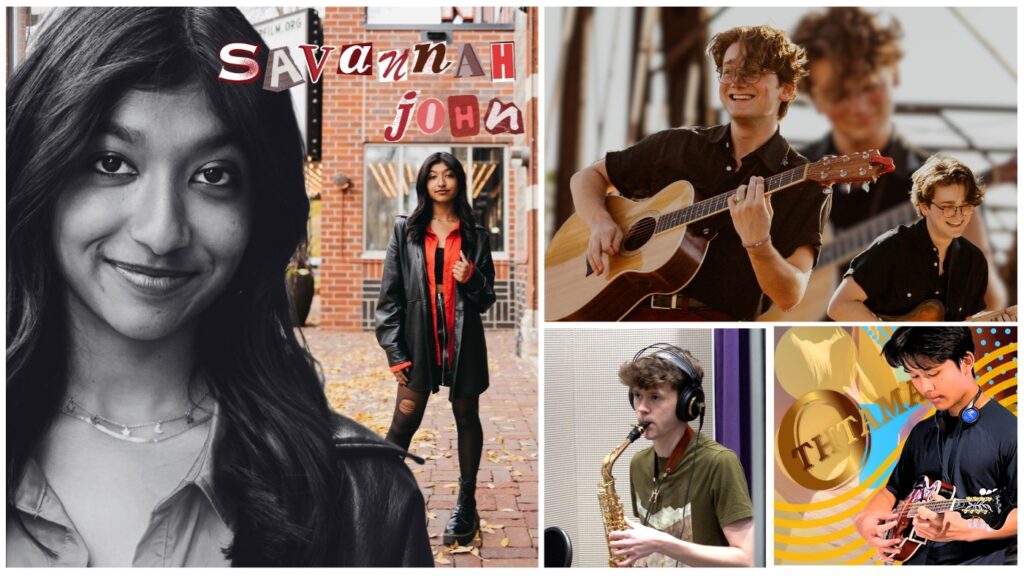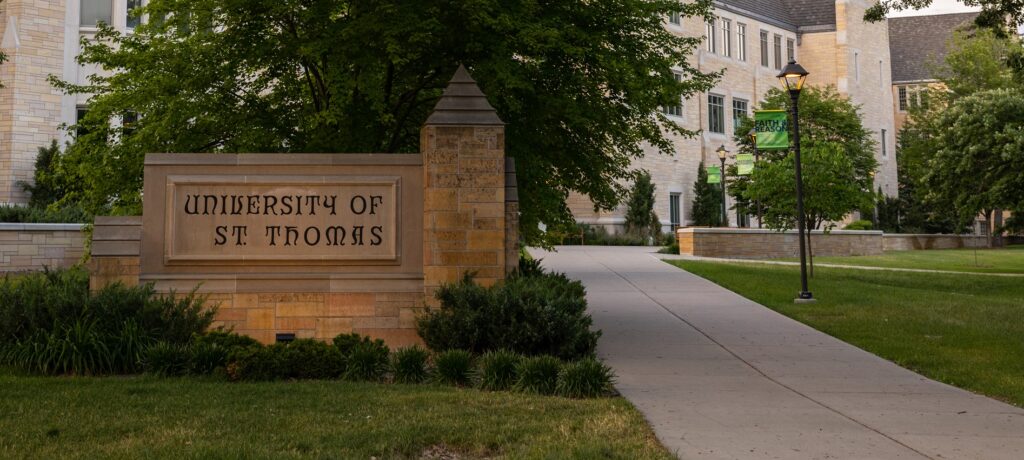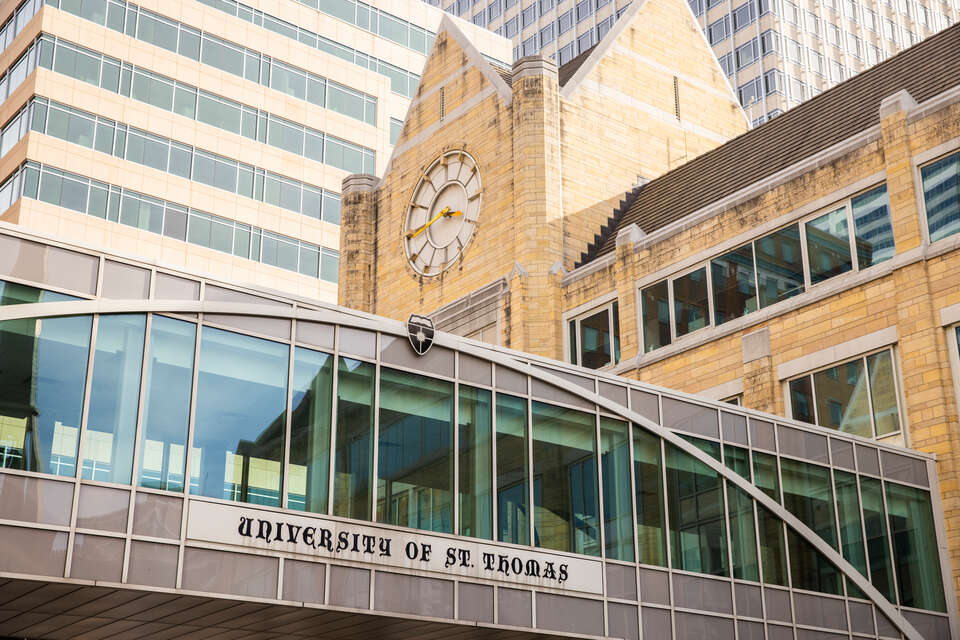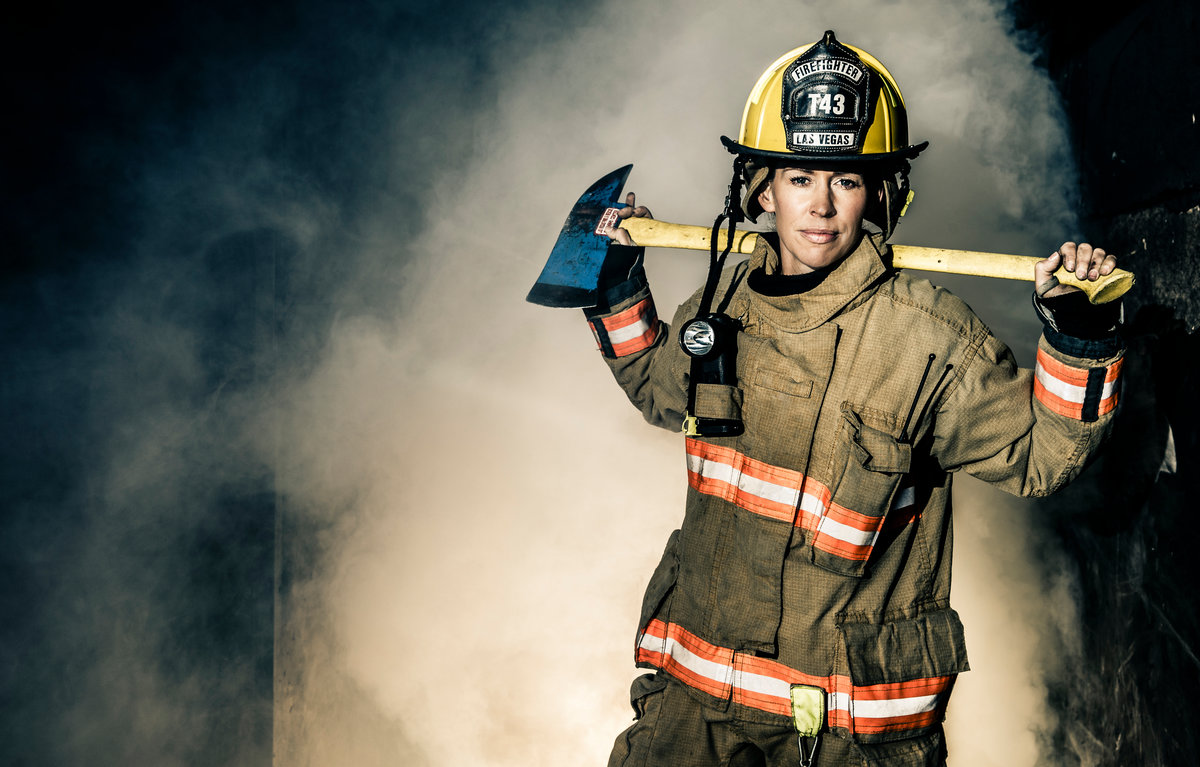
The mental and physical fortitude required to become a firefighter is monumental even for the toughest stock. Women – who make up less than 4 percent of all firefighters in the United States – face singular trials.
Aimee (Anderson) Thatcher ’96 will tell you as much. A full-time firefighter with Las Vegas Fire and Rescue since 2006, she hasn’t figured out yet how to respond when someone tells her she doesn’t look like a firefighter. So she usually just smiles and says “Thank you.” She knows from experience that “when people think of a firefighter, they don’t see me,” she said. “They see a big, handsome dude who’s going to save their life.”
One of 27 women among 650 firefighters in the LVFR and the sole woman in her station of 30, Thatcher can climb a 24-foot ladder while wielding a chainsaw like the best of them. In doing that, and more, she’s showing firefighters have more than one image.

Passion for fitness, helping others
“It probably sounds strange that I went to college and I’m now a firefighter,” Thatcher said. Well, not exactly. That she now works in one of the most physically and emotionally demanding careers there is doesn’t seem like a stretch for a woman who, beginning at 12 years old, arose at 5 a.m. to squeeze in a Jane Fonda workout before the start of school. A woman who finished an Ironman triathlon on a day that saw 5-foot waves on the swim course and wind gusts up to 40 mph. Who, three months after giving birth to her first child, completed the formidable, pass/fail Candidate Physical Ability Test, or CPAT, that all aspiring firefighters must execute without a stumble in under 10 1⁄2 minutes.
Faithful to her long-held commitment to “make a difference in the world,” and follow her passion for fitness, Thatcher made a place for herself at St. Thomas from the get-go. Her freshman year she joined the track and field team. During her first year she also nabbed a job as manager of the football team and ran the equipment room. She began teaching aerobics classes under the auspices of PE100 her sophomore year. “I basically wound up living in the athletic building,” she said.
Academically, Thatcher had in mind that politics was the natural career course for someone with her aspirations and initially steered toward political science; however, the coursework didn’t fulfill her as she’d hoped, so after a year she poked around academic advising and discovered her calling in exercise science.
“When I found out I could major in something that would allow me to work out for a living, I thought, ‘You’ve got to be kidding me!’” she said. “I really credit St. Thomas with enlightening me to the fact that there was such a thing as a career in corporate fitness, where you help people get fit and healthy in the workplace. I knew immediately that it was for me.”
After graduation the Star Tribune hired her full time to design its wellness program. A year later, she moved “wherever the wind took me” in pursuit of advanced opportunities. At a friend’s suggestion, she moved to San Diego, found a comparable job at a gym and steadily rose in the ranks of her field, hopping off track once to accept an offer to teach middle schoolers. After a couple of years she returned to corporate fitness and eventually was promoted to senior program manager at Club One, the corporate fitness company of the technology company AMD, in Austin, Texas.
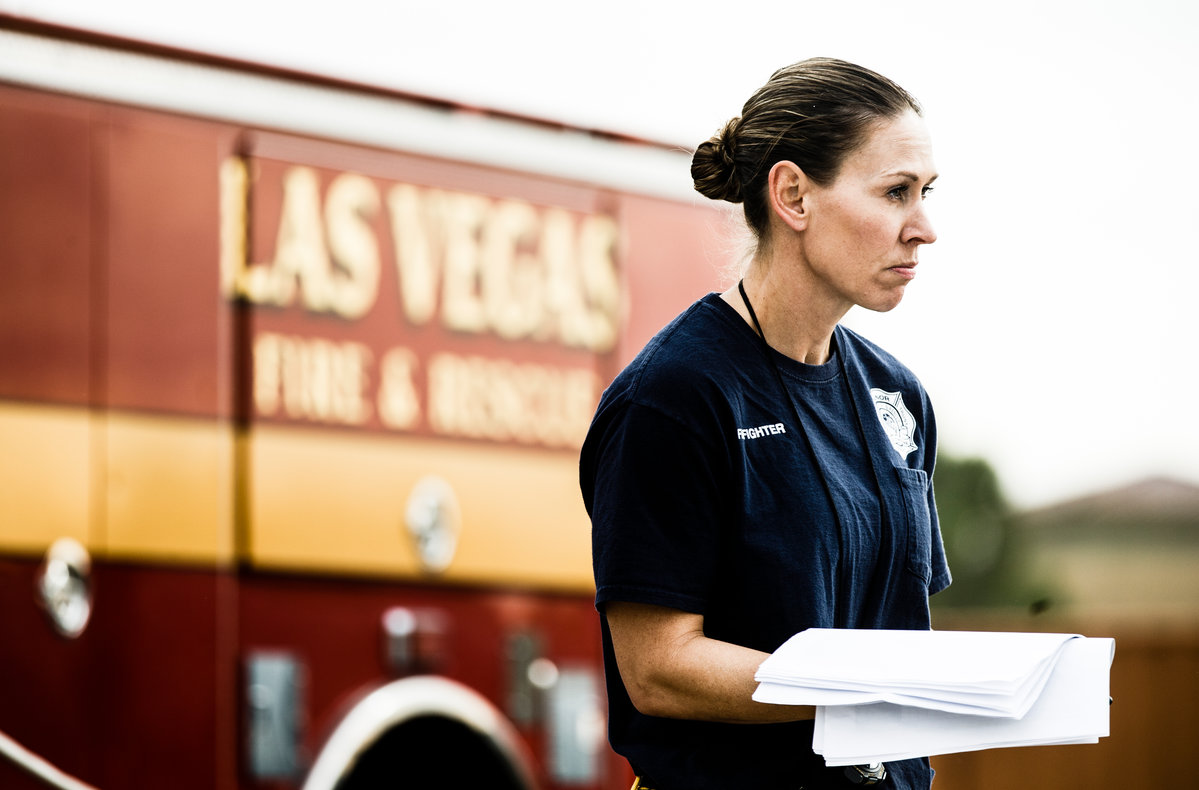
Thatcher keeps an eye on recruits at the Las Vegas Fire Department Training Center in Las Vegas, Nevada.
Listening to Thatcher recount her memories of working in health programming and fitness is telling. Her choice to pursue firefighting – work that would take her into people’s homes “at their worst times” to help them in their greatest need – seems a natural, even inevitable, trajectory for one so deeply inspired by others’ success stories.
“When you take someone who is unfit and make them fit, you give them a super power,” Thatcher said, her voice radiant as she recalled memories of helping ordinary folks turn their lives around. “Every aspect of their life is better, and they can do things they couldn’t do before. Getting them to that point where they are making those healthy choices on their own was amazing.”
Igniting a career change
The person to spark her interest in firefighting? None other than her husband, Jared Thatcher, a 15-year veteran of firefighting who now is with the North Las Vegas Fire Department.
During the first five years of his career – with the Austin (Texas) Fire Department – he remembered how “Aimee would light up when she’d do a ride-along with us when we got an EMS call.” It didn’t take long for him to suggest she try a career change.
“I think a lot of guys would think strongly against encouraging their better halves to get into it, but number one, Aimee is a strong athlete, and number two, she loves to help people. I never had any doubt that she could do the job,” he said.
Even so, both he and Thatcher had some concerns about her entering an ultramasculine line of work in which she most likely would not have a female co-worker.
“It’s definitely a big machismo field. Most firefighters are Type A. They speak their minds. And they’re very competitive,” Jared said. “Everyone wants to prove who can stay in (a fire) the longest or who can make a bottle (oxygen tank) last the longest. But the reality, I told her, is that it doesn’t matter if you’re a firefighter or a dentist, if there’s a will there’s a way, and she’s very strong-willed.”
Hiring process
The (at least) yearlong hiring process is fiercely competitive and is designed to separate the strongest from the merely strong. It begins with a city or county’s call for recruits. Hopefuls take a 120-question written test, which, in Las Vegas departments attracts between 1,000 and 2,000 applications. Most do not pass the first time. The lucky few who do then run a gauntlet of trials, including the CPAT, a background check, various behavioral and psychological evaluations, and two rounds of oral board interviews.
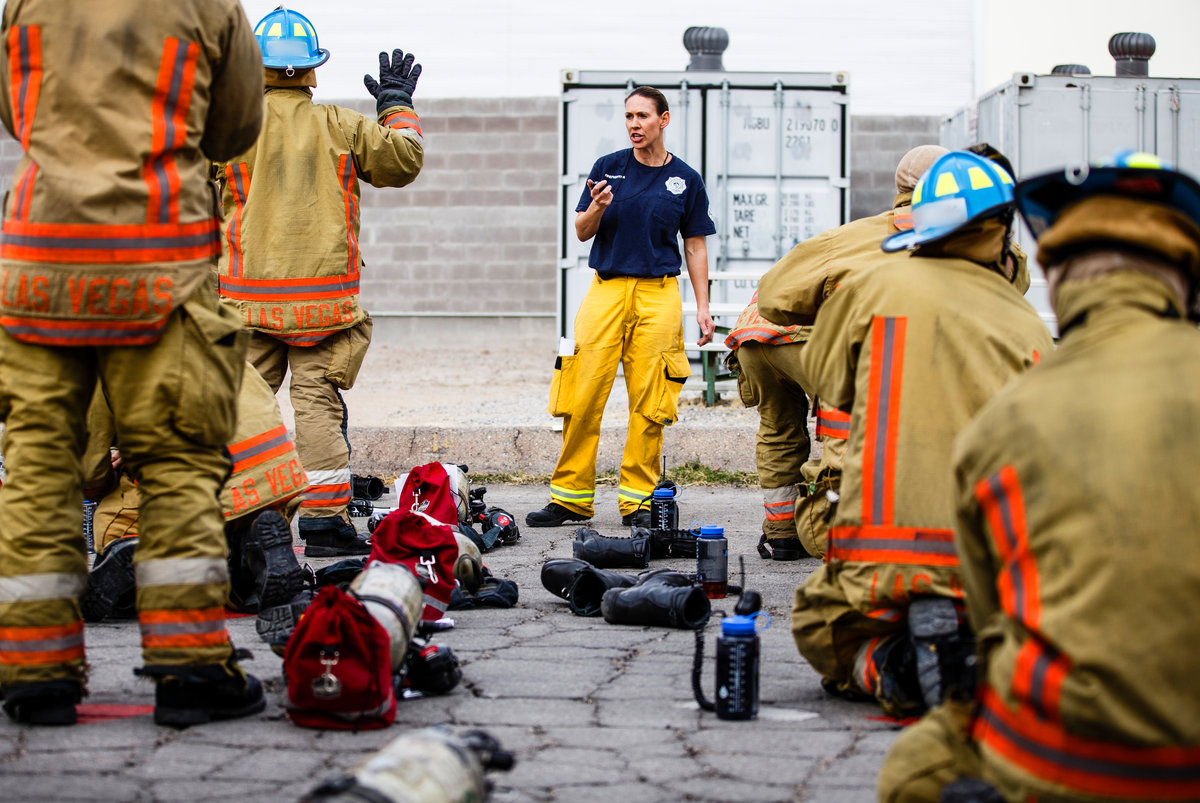
Thatcher times new recruits as they put on their turn out gear. A time longer than 45 seconds is a failing mark. Note that recruits are not allowed to be identified, so names on helmets have been obscured.
Contrary to the opinion of some, concessions are not given to women who take the CPAT. The test includes a 14-story climb on a stepmill in three minutes, 20 seconds while wearing a 75-pound weighted vest; an obstacle course of barrels around which candidates lug a fire hose in full “turnout” gear – the 55-pound uniform and equipment firefighters wear when responding to an emergency; a feat of strength in which one swings a sledgehammer against a calibrated target until it registers the minimum required force; and a 175-pound dummy drag for 50 feet. Thatcher completed the test in 8 1⁄2 minutes.
Those who succeed go on to academy, which lasts anywhere from 18 to 36 weeks depending on the department, according to Thatcher. Candidates are ranked again before individual stations select their hires. One is deemed a firefighter only after he/she successfully completes six months of on-the-job probation.
Something to prove
Thatcher believes the percentage of full-time female firefighters in the United States has remained low in large part because most departments, in large part, haven’t learned how to invite women and embrace their strengths.
Among the challenges she noted were the persistent tests – veiled or otherwise – of their skills as firefighters. “There are definitely moments when I’ve felt discriminated against because I’m a woman. To say it doesn’t happen would be ridiculous. It’s hard being a female in a male-dominated environment. That goes without saying,” she said.
Capt. Karen Cutolo, a 17-year veteran of LVFR, was assigned to mentor Thatcher during Thatcher’s six-month rookie, or probationary, phase. Cutolo’s first impression of her was encouraging: “When I first saw her I thought, ‘Wow, she’s in phenomenal shape and has a great, positive attitude.’ You could tell she wanted to be there and was very motivated.”
Cutolo handles gender misconceptions in firefighting no differently than how she handles them in society at large. It’s this perspective she remembers wanting to instill in Thatcher.
“Women are looked at harder,” she noted. “It’s mentally challenging to the point that some women do give up.” To help Thatcher assuage some of the pressure, Cutolo advised her in a way similar to all rookies but noted that her advice holds greater weight for the women: “I teach them, ‘This is what’s going to get you by ... do things smarter, not harder; don’t ever let them see you with your head down on the fire grounds. Fake it till you make it.’”
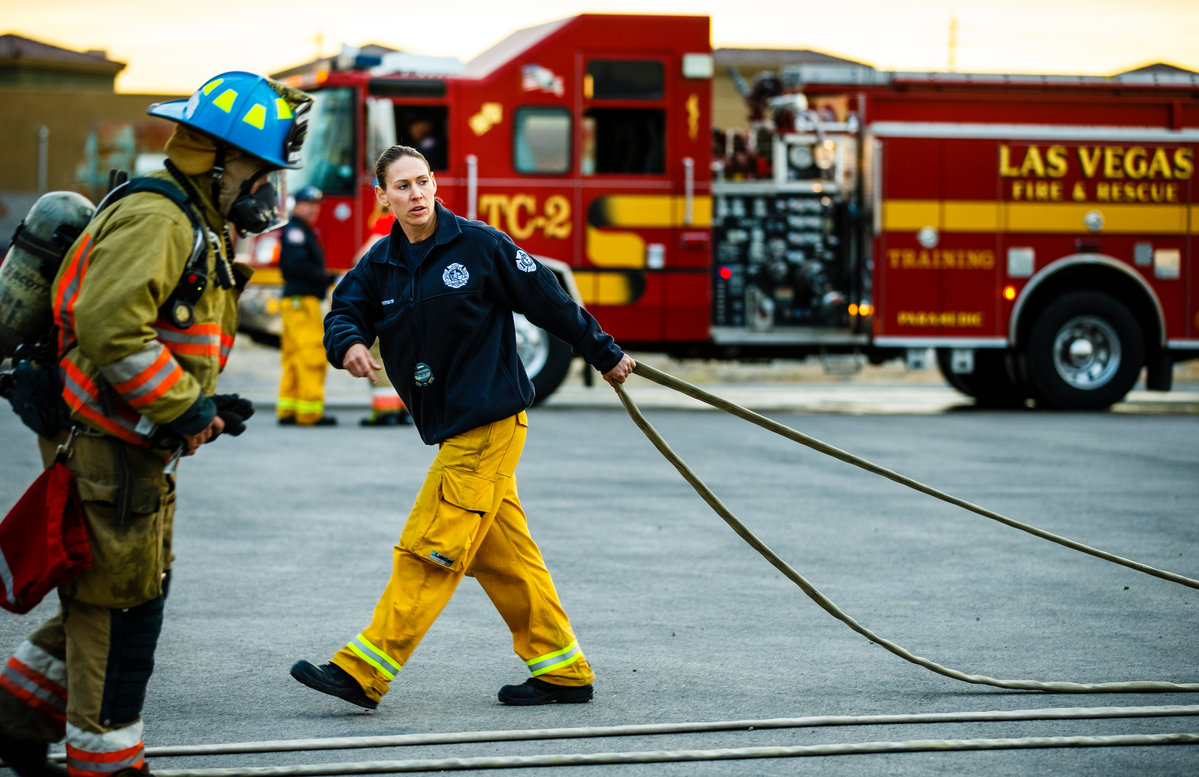
Thatcher coils up hose following a recruit's timed training exercise.
Thatcher shared a memory of when she, her male partner and their former captain arrived to the scene of emergency. “I had to throw the ladder, I had to get the chainsaw, I had to get the fan ... while my partner did nothing, and I couldn’t say anything because I had to follow orders. It’s not like I was on probation, either, so it was obvious he was testing me,” she said.
“I got that a lot,” she continued. “‘Can she do that?’ ‘Is she as strong as a guy?’ That’s what they want to know, which is so silly because I had to do all that stuff to pass. ... The fact is I’m stronger than some men on the job and not as strong as others. It is what it is.”
A sister in the house
Thatcher sometimes jokes with her fellow crew that life at the station (when they are not responding to an emergency) is more fun for men because it’s “like a sleepover to them.”
Fire station life, she added, is “a different culture” from the 9-5 office jobs familiar to most. Full- time firefighters work 10 24-hour shifts per month, during which they eat, travel, sleep and, of course, protect, together.
Firefighting “has tradition, brotherhood, a sense of fraternity, all those things. ... So while the people at my station are my crew, my family, my identity, I’m not a brother. I’m a sister,” Thatcher insisted. “And for me that sometimes makes me feel like an outsider, even now, although they’re getting better at recognizing both.
“Gender isn’t something that determines a person’s success or failure in any area or job,” Thatcher added. “Success to me is based on an individual’s – man or woman – ability to do what needs to be done when it needs to be done.”
Though unapologetic in discussing her conventionally feminine side – off-duty, she likes to wear make-up and jewelry, go shopping and get manicures – at the station Thatcher sports a plain face and a fuss-free low bun to avoid the stereotypes associated with, say, eye shadow and curling irons. In Thatcher’s words: “I don’t flaunt that I’m female because I’m in their environment.”
Thatcher talks, her weariness palpable, of how exhausting it is to be “one version” of herself at work. Tapping into her full version, understandably, would come in handy back at the station in the aftermath of some of the emergency scenes her crew has been called to: a family of four dead inside a crumpled SUV struck by a drunk driver; parents wailing above the still, blue body of their drowned child.
“I think of all the things I don’t talk about at work. Things I would talk about with my girlfriends. That’s what it’s like for me,” she said. “When we’re responding to a call, we work as a team, and it’s really stressful. When we get back to the station there’s a decompression and they get to have their guy time. They talk about their trucks and compare diesel engines ... things I’m not interested in,” she said, chuckling. “I’d love to be able to come to work and talk about ‘girl stuff.’”
Paving the way for herself, future women
Thatcher and her crew also make regular school visits for community outreach. The sight alone of her in full gear, she hopes, will show other girls that firefighting is a career choice, among many, within their reach.
“If I can show up with my feminine energy and help even one girl grasp that becoming a firefighter is an attainable goal – and this will be the thing she absolutely loves – then that will be something,” she said.
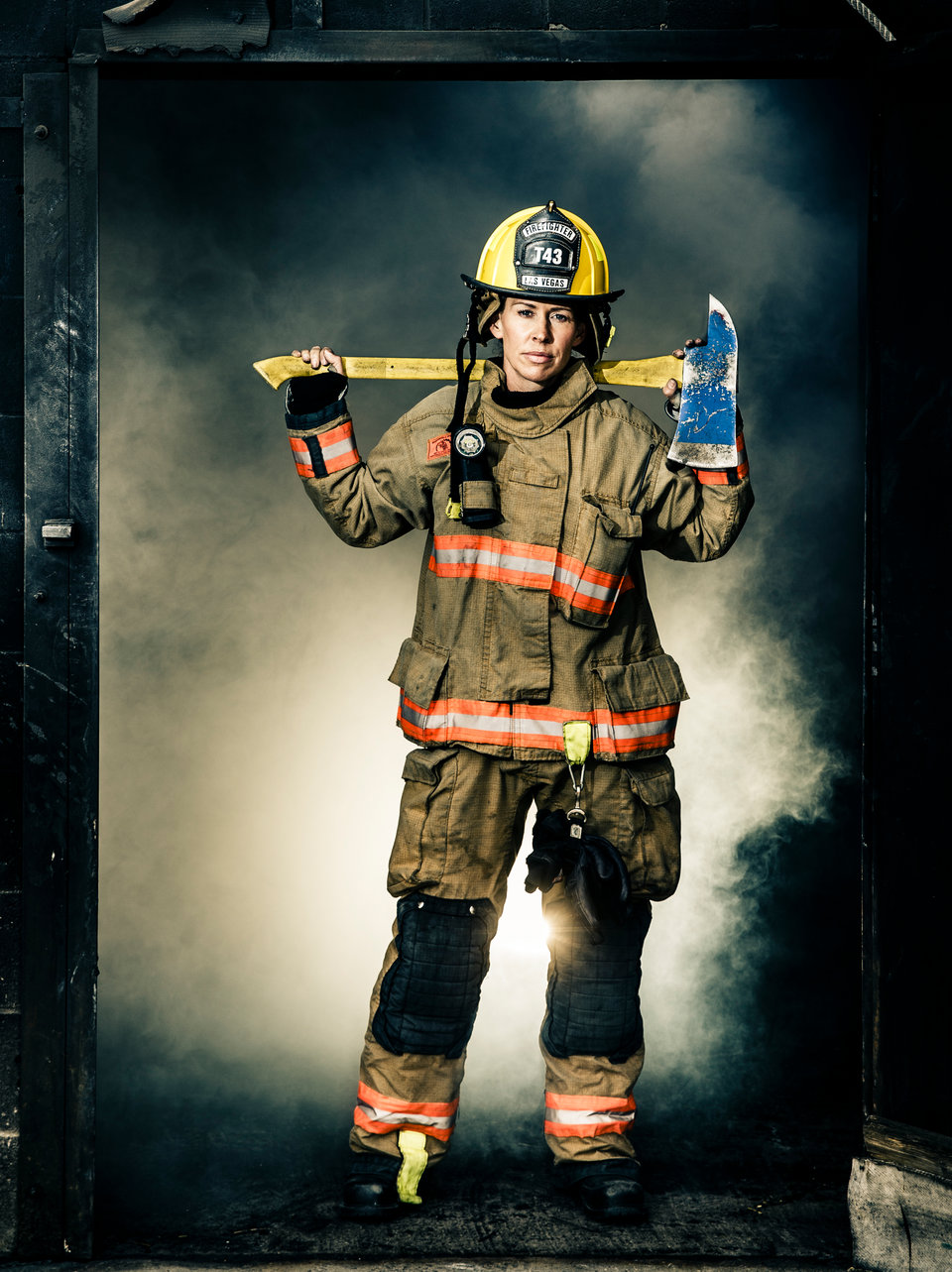
“We help people in their worst times. That’s why I do this,” she added. “The women who came 20 years before me had it really rough. It’s better for me because they paved the road. That’s the big picture I look at when I get discouraged.”
An opportunity to once again co-mingle her passion for fitness with her job recently presented itself. In November she began a temporary assignment as a recruit training officer at the Las Vegas Fire and Rescue Academy. She has six months to whip the newest batch of recruits – 27 men – into the best shape of their lives.
“My personality is that I’m goal-oriented. I like to lead. I like being a boss. That’s something I miss – guiding and fostering people to reach their next level, so I’m excited to get back to my roots,” she said.
Her proudest moments on the job? “I’m proudest that I did it. I passed the tests, I completed the academy and probation, and now I’m a firefighter and I get to work alongside some of the best firefighters in the nation.
“One of my favorite parts of the job is when we’re in the firetruck driving down the road with the windows down. Kids will see us drive by and they smile and wave. It makes you feel like a hero the way they look at you. I always smile and wave back thinking, ‘I can’t believe I’m actually here.’”
Read more from St. Thomas magazine.
